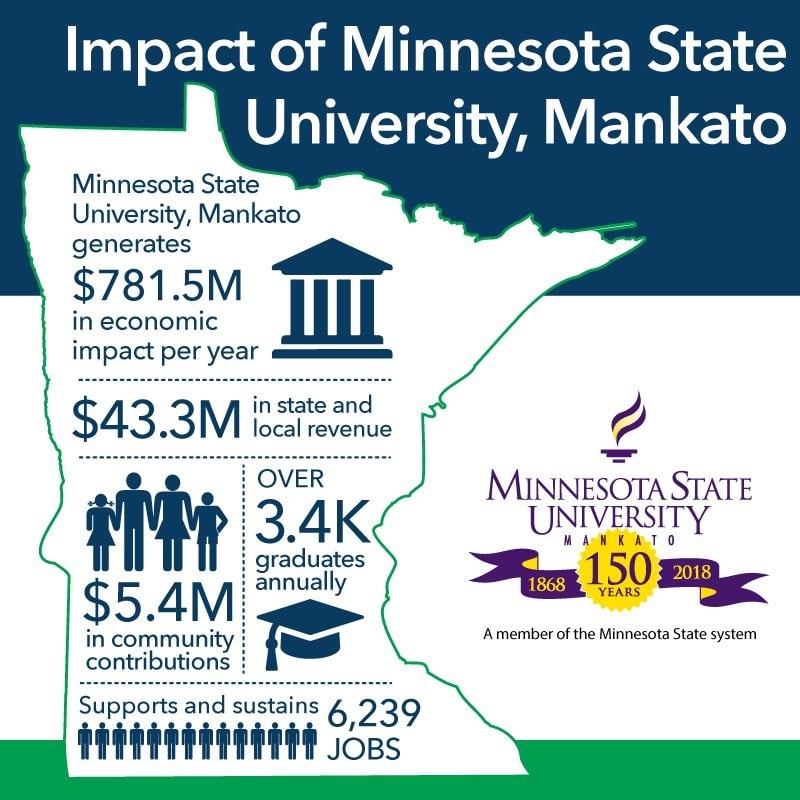Minnesota State Mankato’s Economic Contribution Estimated at more than $781 million
Study on economic impact was produced by national consulting firm Parker Philips.
- Mankato Free Press coverage
- KEYC TV coverage
- Minnesota State Mankato's economic impact Web page
- Download the full Minnesota State Mankato economic impact report (PDF).
- For the full economic contribution analysis of the Minnesota State system, visit the Minnesota State Impact website.
- Minnesota State system news release on the Parker Philips economic impact study
 Mankato, Minn. – Minnesota State, the system of 30 state colleges and seven state universities, today released the results of a study that estimates the contribution of Minnesota State University, Mankato to the regional economy to be $781,491,074 and 6,239 jobs (both totals are direct, indirect and induced).
Mankato, Minn. – Minnesota State, the system of 30 state colleges and seven state universities, today released the results of a study that estimates the contribution of Minnesota State University, Mankato to the regional economy to be $781,491,074 and 6,239 jobs (both totals are direct, indirect and induced).
“We are proud of the valuable roles our students, alumni, faculty and staff play in contributing to both the state and regional economies,” said Minnesota State Mankato President Richard Davenport. “Our students have been using their ‘big ideas and real-world thinking’ for 150 years to solve problems and find solutions that make life better for those in our region, state and around the world.
“At Minnesota State Mankato, we are planning to build on this study’s results by developing a detailed and extensive community impact statement that shows the broad scope of the role of our University in the regional community.”
The study was commissioned by the Minnesota State system and was conducted by Parker Philips, a nationally recognized consulting firm specializing in economic impact analysis.
“An economic contribution analysis is an objective way to measure the significance of an organization in the regional economy; it is a tool that policy makers can use to inform their decisions,” said Nichole Parker, a principal partner at Parker Philips. “Minnesota State Mankato clearly is a major contributor to the regional economy.”
In the analysis, the study considered the direct spending on operations, pay, benefits, and capital projects by Minnesota State Mankato and the estimated increase in demand for goods and services in industry sectors that supply or support the University. The study also measured the effect of student spending and the induced effect of increased household income.
According to the study, a key result of this activity is that Minnesota State Mankato supports and sustains 6,239 jobs including direct employment by the University, as well as indirect and induced jobs created by supply and equipment vendors, contractors, and laborers for the construction and renovation of facilities, and jobs created in the community at hotels, restaurants, and retail stores in support of the University’s faculty, staff, students and visitors.
The study also calculated tax revenues generated by this level of economic activity, including sales, property, personal income, and corporate income taxes. The study concluded that Minnesota State Mankato generates about $43,343,804 in tax revenues for state and local government.
The study further estimated the value of the increase in productivity that the degrees awarded by Minnesota State Mankato yield throughout the careers of the graduates. Assuming a 40-year work life, the education received by these graduates will yield additional state income of $55.9 billion (future value, discounted and adjusted to account for such factors as foregone income while attending school and outmigration).
“With more than 123,000 alumni, Minnesota State Mankato graduates make a long-term contribution to the regional and state economies because the impact of each graduate’s college education lasts for an individual’s entire career,” said Davenport.
Statewide, all Minnesota State system operations, including all seven state universities and 30 community and technical colleges, plus the spending of its faculty, staff, and students, had a total statewide economic contribution of $8.0 billion. This activity generated an estimated 67,717 jobs in the state.
The economic contribution report for Minnesota State Mankato is available at: mankato.mnsu.edu/about-the-university/fast-facts/economic-impact/
Minnesota State Mankato, a comprehensive university with approximately 15,000 students, is part of the Minnesota State system, which includes 30 colleges and seven universities.
About the Minnesota State system
The Minnesota State system includes 30 community and technical colleges and seven state universities serving approximately 375,000 students. It is the fourth-largest system of two-year colleges and four-year universities in the United States.


